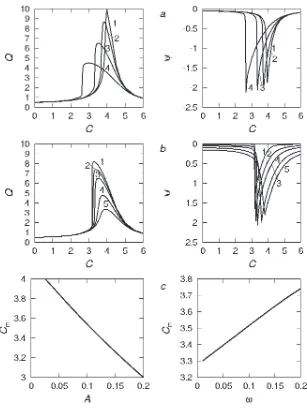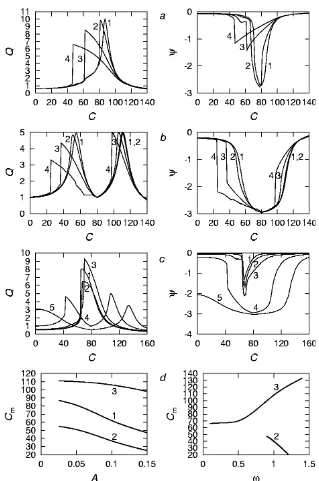LETTER TO THE EDITOR
Vibrational resonance
P S Landa† and P V E McClintock‡
† Department of Physics, Lomonosov Moscow State University, 119899 Moscow, Russia ‡ Department of Physics, Lancaster University, Lancaster LA1 4YB, UK
Received 8 September 2000
Abstract. The effect of a high-frequency force on the response of a bistable system to a low-frequency signal is considered for both the overdamped and weakly damped cases. It is shown that the response can be optimized by an appropriate choice of vibration amplitude. Thisvibrational resonancedisplays many analogies to the well known phenomenon of stochastic resonance, but with the vibrational force filling the role usually played by noise.
Stochastic resonance (SR) [1–3] is commonly said to occur when a weak periodic signal in a nonlinear system is amplified by an increase in the ambient noise intensity. In this Letter, we point out that an analogous phenomenon can occur when the noise is replaced by a high-frequency periodic force†. We will refer to it asvibrational resonance(VR). As we shall see, there are some interesting distinctions, as well as close analogies, between VR and SR.
SR is usually considered for the simplest possible example of an overdamped bistable oscillator described by the equation
˙
x+f (x)=Acosωt+ξ(t) (1)
whereAcosωt is the weak input signal,f (x) = dU(x)/dx,U(x)is a symmetric double-well potential (for example,U(x)= −x2/2 +x4/4),ξ(t)is white noise of intensityK, i.e.
ξ(t)ξ(t+τ) = Kδ(τ). The response of the system to the input signal can be considered either in terms of a linear susceptibility [6] or, as here, in terms of an effective stiffness [7]. SR occurs when the susceptibility or stiffness displays a nonmonotonic dependence on noise intensity, such that the responseQpeaks at a particular valueKm of the noise intensityK.
The complex amplitudeBof the signal componentsω(t)at frequencyωmay be described by the linearized equation
iωB+c(A, ω, K)B=A (2)
wherec(A, ω, K)is a complex quantity. Its real partcr(A, ω, K)may be treated as an effective
stiffness [7], whereas its imaginary partci(A, ω, K)is proportional to what is effectively an
additional damping factor. For SR to occur, it is essential thatc(A, ω, K)should depend on the noise intensityK.
It is evident, however, that a change inc(A, ω, K)may be induced, not only by noise, but also by other kinds of high-frequency force such as, for example, a periodic vibration. Such a phenomenon would represent another example of a change in the dynamical behaviour
Letter to the Editor
and properties of a nonlinear system induced by high-frequency vibration (see the book by Blekhman [8]). We first consider this possibility in relation to the overdamped bistable oscillator
˙
x−x+x3=Acosωt+Ccost (3) i.e. where the white noiseξ(t)of (1) has been replaced by the rapidly oscillating periodic force Ccos(t)withω. We evaluate the response of the system to the input signalAcosωt (by analogy with a lock-in amplifier) by calculating the sine and cosine components,Bsand
Bcrespectively, of the coordinate variations (output signal), yielding
Bs=
2 nT
nT
0
x(t)sinωtdt Bc=
2 nT
nT
0
x(t)cosωtdt (4)
whereT =2π/ωandnis an integer. Computing equation (3) and extracting the cosine and sine constituents of the output signal at frequencyω, we thus find the dependences onCof both the response amplitudeQ=B2
s +Bc2/Aand the phase shiftψ= −arctan(Bs/Bc)of
the response relative to the input signal. Some results for a fixed value of=5 and different values ofAandωare plotted in figure 1.
It is immediately apparent from figures 1(a) and (b) that the form ofQ(C)is qualitatively similar to what is seen in SR [1–3]: the responseQat first increases with increasing amplitude Cof the high-frequency force, but then passes through a maximum and decreases again. The maxima inQ(C)are in general sharper than are found in the case of SR. The phase shifts (C)are also reminiscent of those found in SR [9] but, again, exhibit very much sharper minima. For bothQ(C)and(C), the positions of the extrema are weakly dependent onA andωrespectively, as shown in figure 1(c). The mechanism underlying VR can be understood as a reduction in the effective stiffness of the system induced by the high-frequency force [7], resulting in amplification of the low-frequency signal. Equivalently, it can be perceived in terms of changes in the depth of a smoothed auxiliary potential, as discussed earlier [10] for a quasimonochromatic force: here, signal amplification occurs when the low-frequency signal is first able to induce inter-well transitions; the nearly discontinuous rise inQ(C)with increasingC corresponds to the minimum value ofC at which the central maximum in the auxiliary potential can be destroyed at the peak signal values. The amplification decreases again when the amplitude of the high-frequency vibrational force has increased sufficiently to annihilate completely the double-well character of the auxiliary potential (and that of the real potential over most of each forcing period).
There is a clear analogy between SR and VR in the simple overdamped systems (1) and (3) respectively. We note that other authors have considered the effect of multi-frequency forces applied to nonlinear oscillators (see e.g. [11, 12]) but, to our knowledge, the phenomenon of vibrational resonance has not previously been identified or reported.
It is also of interest to establish whether VR arises in underdamped systems. As an example, we consider the weakly damped bistable oscillator
¨
Figure 1. Response of the overdamped system (3) to the weak periodic signalAcosωt, as influenced by the high-frequency vibrational forceCcostwith=5, for different conditions: (a) the response amplitudeQand corresponding phase shiftψare plotted as functions ofCfor
ω=0.1 withA=0.025,A=0.05,A=0.1 andA=0.2 (curves 1, 2, 3 and 4, respectively); (b) as in (a) but forA=0.1 withω=0.01,ω=0.05,ω=0.1,ω=0.2 andω=0.3 (curves 1, 2, 3, 4 and 5, respectively); (c) plots of the characteristic vibration amplitudesCmcorresponding to
maxima inQ(C)as functions of the signal amplitudeA(left) andω(right)
Numerical simulation of equation (5) confirms these ideas. Some typical results are presented in figure 2 for different values ofAandω. The variations of the response amplitude Q(C)and phaseψ(C)with the amplitudeCof the high-frequency vibrational force shown in figures 2(a) and (b) are markedly dependent on the signal frequencyω, unlike the case of the overdamped oscillator (3) (cf figures 1(a) and (b)).
Letter to the Editor
Figure 2. Response of the underdamped system (5) withδ = 0.1 to the weak periodic signal
Acosωt, as influenced by the high-frequency vibrational forceCcostwith = 9.842, for different conditions: (a) the response amplitudeQand corresponding phase shiftψare plotted as functions ofCwithω=0.5 forA=0.025,A=0.05,A=0.1 andA=0.15 (curves 1, 2, 3 and 4, respectively); (b) as in (a) but forω=1; (c) as in (a) but forA=0.08,ω=0.1,ω=0.25,
ω=0.5,ω=1 andω=1.4 (curves 1, 2, 3, 4 and 5, respectively); (d) plots of the characteristic vibration amplitudesCmcorresponding to maxima inQ(C)as functions of signal amplitudeA
Figure 3.Dependences of the response amplitudeQand phase shiftψonωforδ=0.1,=9.842,
A=0.05: (a) for vibration amplitudesC=0,C=25,C=40 andC=60 (curves 1, 2, 3 and 4, respectively); (b) forC=80,C=100,C=120 andC=140 (curves 1, 2, 3 and 4, respectively); (c) plot of the resonance frequencyωras a function ofC
Letter to the Editor
If the signal frequency is too far from the intra-well free resonance, the intra-well oscillation cannot be brought into resonance by the high-frequency vibration, and so only one maximum ofQ(C)is observed. Again, such behaviour is very similar to the case of stochastic resonance in a weakly damped bistable oscillator [7].
Figures 3(a) and (b) illustrate the resonant dependences of the responseQ(ω)and phase shiftψ(ω)onωfor a fixed value ofAand different values ofC. In contrast to the overdamped oscillator (3), for a weakly damped oscillator these dependences are resonant in character, just as reported earlier for SR in the underdamped monostable oscillator [14]. AsCincreases, the resonant frequency at first decreases, but then increases again (see figure 3(c). Thus, we can control the resonant frequencyωrby changing the amplitude of the high-frequency vibration.
In conclusion, we have shown that the phenomenon ofvibrational resonance, in which a weak periodic signal can be optimally amplified by the application of high-frequency periodic force of appropriate amplitude, can occur in both overdamped and underdamped nonlinear oscillators. It can be perceived as a form of stochastic resonance in which the noise has been replaced by a high-frequency periodic force.
We acknowledge valuable discussions with V I Babitsky, I I Blekhman, M I Dykman, R Mannella and S M Soskin. The work was supported in part by the Science and Engineering Research Council.
References
[1] Dykman M I, Luchinsky D G, Mannella R, McClintock P V E, Stein N D and Stocks N G 1995Nuovo Cimento
D17661
[2] Gammaitoni L, H¨anggi P, Jung P and Marchesoni M 1998Rev. Mod. Phys.70223
[3] Luchinsky D G, Mannella R, McClintock P V E and Stocks N G 1999IEEE Trans. Circuits Systems II: Analog Digital Signal Process.461205
Luchinsky D G, Mannella R, McClintock P V E and Stocks N G 1999IEEE Trans. Circuits Systems II: Analog Digital Signal Process.461215
[4] Benzi R, Sutera A and Vulpiani A 1981J. Phys. A: Math. Gen.14L453 [5] McNamara B, Wiesenfeld K and Roy R 1988Phys. Rev. Lett.602626
[6] Dykman M I, Mannella R, McClintock P V E and Stocks N G 1990Phys. Rev. Lett.652606 [7] Landa P S 2000Regular and Chaotic Oscillations(Berlin: Springer) at press
[8] Blekhman I I 2000Vibrational Mechanics(Singapore: World Scientific) (Russian original: 1994 (Moscow: Nauka))
[9] Dykman M I, Mannella R, McClintock P V E and Stocks N G 1992Phys. Rev. Lett.682985 Dykman M I, Mannella R, McClintock P V E and Stocks N G 1993Phys. Rev. Lett.70874 [10] Dykman M I, Mannella R, McClintock P V E, Stein N D and Stocks N G 1993Phys. Rev.E473996 [11] Nayfeh A H and Mook D T 1979Nonlinear Oscillations(New York: Wiley-Interscience)
[12] Dykman M I and Krivoglaz M A 1984Soviet Physics Reviewsvol 5, ed M I Khalatnikov (New York: Harwood Academic) pp 265–442

